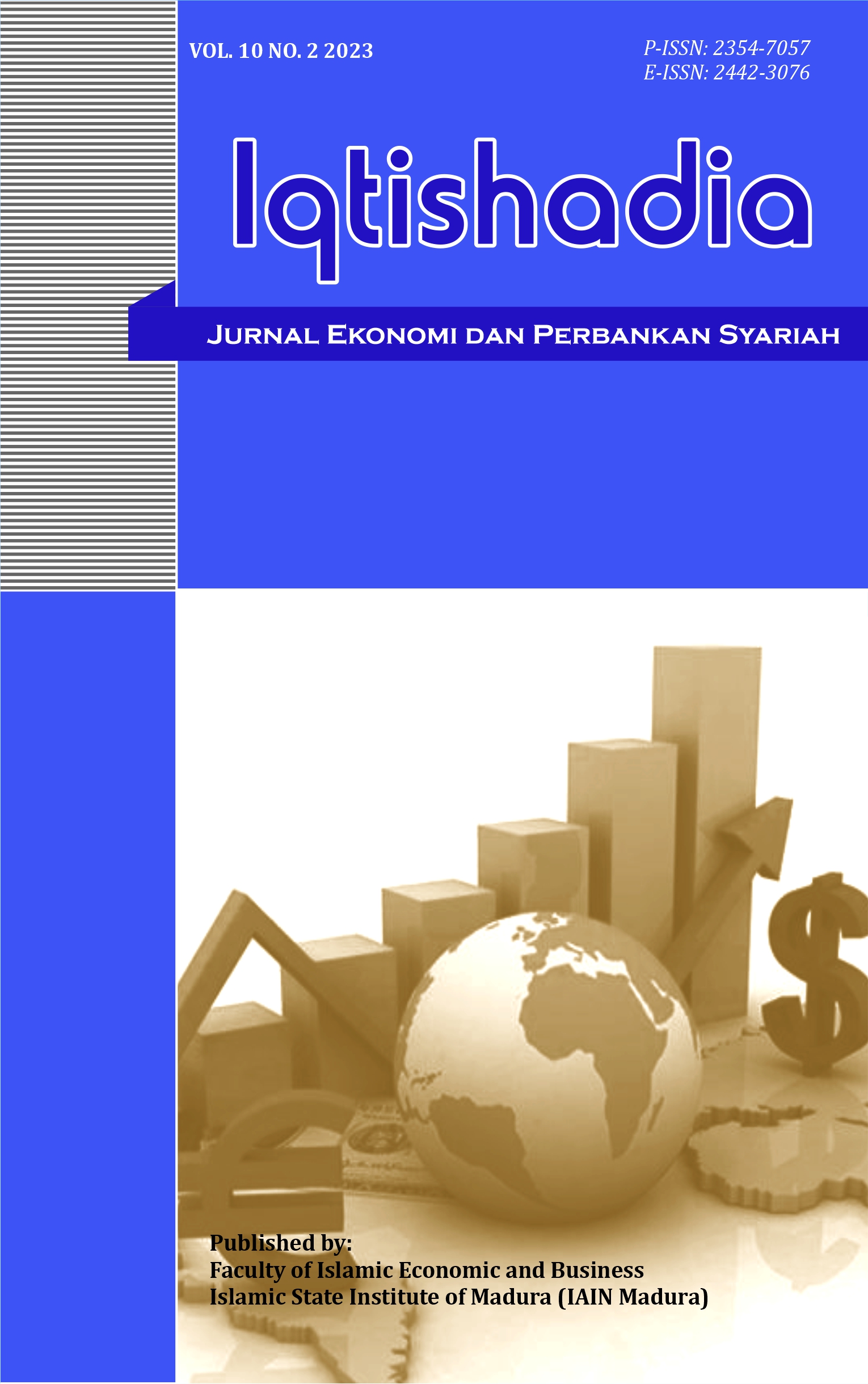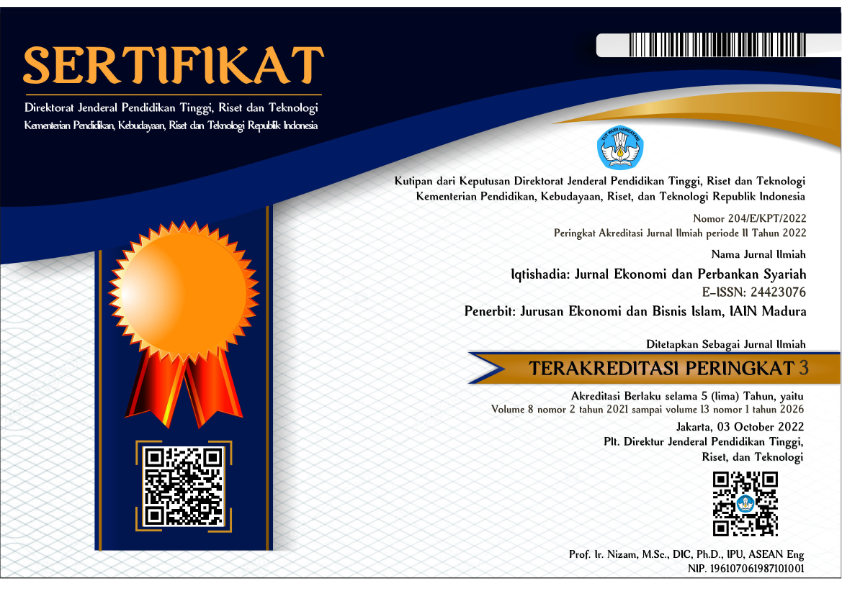Pinpointing the Determinants of Financial Literacy: Empirical Evidence of Indonesian Employees in Malaysia
 Abstract views: 338
,
Abstract views: 338
,
 PDF downloads: 212
PDF downloads: 212
Abstract
This paper investigates the determinants variables of financial literacy through Exploratory Factor Analysis among Indonesian employees’ works in Malaysia. This study is quantitative study with 117 respondents. The data from respondents are collected through questionnaire on five-point Likert scale. Data analysis employs EFA (Exploratory Factor Analysis) which reduce the factors into expected variables. The study found that there 7 factors emerged in based on data analysis namely, financial literacy contributes with higher percentages factors 13.93%, financial planning contributes with 11.28%, financial control with 9.86%, exchange rate awareness with 9.52%, financial attitude with 9.07, financial subjective norms with 8.76, and lastly financial awareness contributes 6.93%. Meanwhile, simultaneously all variables have commutative percentages about 69.38%. Further studies are required to investigate or examine each emerged variables for example, SEM, Regression analysis, One Way ANOVA, and so on. Moreover, wider coverage of research sample and research object also suggested.
Downloads
References
Anshika, Anju Singla, and Girijasankar Mallik. “Determinants of Financial Literacy: Empirical Evidence from Micro and Small Enterprises in India.” Asia Pacific Management Review 26, no. 4 (December 2021): 248–55. https://doi.org/10.1016/j.apmrv.2021.03.001.
Asare Vitenu-Sackey, Prince, and Richard Barfi. “The Impact of Covid-19 Pandemic on the Global Economy: Emphasis on Poverty Alleviation and Economic Growth.” The Economics and Finance Letters 8, no. 1 (2021): 32–43. https://doi.org/10.18488/journal.29.2021.81.32.43.
D’Ambrosio, Conchita, Markus Jäntti, and Anthony Lepinteur. “Money and Happiness: Income, Wealth and Subjective Well-Being.” Social Indicators Research 148, no. 1 (February 12, 2020): 47–66. https://doi.org/10.1007/s11205-019-02186-w.
Dewi, Vera, Erie Febrian, Nury Effendi, and Mokhamad Anwar. “Financial Literacy among the Millennial Generation: Relationships between Knowledge, Skills, Attitude, and Behavior.” Australasian Business, Accounting & Finance Journal 14, no. 4 (2020): 24–37. https://doi.org/10.14453/aabfj.v14i4.3.
Ernawati, Wanti, Puji Astuty, Darwati Susilastuti, and Rudi Bratamanggala. “Indonesia’s Macroeconomic Development During the Covid-19 Pandemic Between Obstacles, Challenges and Opportunities in the New Normal Era.” In Proceedings of the 2nd International Conference on Law, Social Science, Economics, and Education, ICLSSEE 2022, 16 April 2022, Semarang, Indonesia. Semarang: EAI, 2022. https://doi.org/10.4108/eai.16-4-2022.2319713.
Flores, Andrea, and George-Levi Gayle. “Disparities in COVID-19’s Impact on Employment and Household Consumption.” Review 104, no. 4 (2022). https://doi.org/10.20955/r.104.224-65.
Hair, Joseph F., William C. Black, Barry J. Babin, and Rolph E. Anderson. Multivariate Data Analysis. 7th ed. New York: Pearson Prentice Inc, 2010.
Hidajat, Taofik. Literasi Keuangan. Semarang: STIE Bank BPD Jateng, 2016. https://books.google.co.id/books?id=UBq8DAAAQBAJ&lpg=PA1&ots=FvM5iOTeT7&dq=Hidajat%2C T. (2016). Literasi Keuangan. STIE Bank BPD Jateng&lr&hl=id&pg=PR2#v=onepage&q=Hidajat, T. (2016). Literasi Keuangan. STIE Bank BPD Jateng&f=false.
Hossain, Muktar, and Sumit Kumar Maji. “Antecedents of Financial Literacy: Evidences from West Bengal, India.” SSRN Electronic Journal 8 (2021): 15–36. https://doi.org/10.2139/ssrn.3815190.
Kadoya, Yoshihiko, and Mostafa Saidur Rahim Khan. “Financial Literacy in Japan: New Evidence Using Financial Knowledge, Behavior, and Attitude.” Sustainability 12, no. 9 (May 2, 2020): 3683. https://doi.org/10.3390/su12093683.
Kaiser, Henry F. “An Index of Factorial Simplicity.” Psychometrika 39, no. 1 (1974): 31–36.
Lastauskas, Povilas. “Lockdown, Employment Adjustment, and Financial Frictions.” Small Business Economics 58, no. 2 (February 3, 2022): 919–42. https://doi.org/10.1007/s11187-021-00496-3.
Lavonda, Pamela, Ignatius Roni Setyawan, and Margarita Ekadjadja. “Determinants of Financial Well-Being Among Young Workers in Jakarta During the Covid-19 Pandemic.” Jurnal Ekonomi 26, no. 2 (June 18, 2021): 305–320. https://doi.org/10.24912/je.v26i2.752.
Lee Abdullah, Ainuddin Iskandar. “Malaysia Border Security and Pandemic COVID-19.” In COVID-19 in South, West, and Southeast Asia, 1st ed., 182–92. London: Routledge, 2022. https://doi.org/10.4324/9781003291909-12.
Locke, Edwin A., and Kaspar Schattke. “Intrinsic and Extrinsic Motivation: Time for Expansion and Clarification.” Motivation Science 5, no. 4 (December 2019): 277–90. https://doi.org/10.1037/mot0000116.
Lopus, Jane S., Dwi Sulistyorini Amidjono, and Paul W. Grimes. “Improving Financial Literacy of the Poor and Vulnerable in Indonesia: An Empirical Analysis.” International Review of Economics Education 32 (September 2019): 100–168. https://doi.org/10.1016/j.iree.2019.100168.
Malina, A. “The Factor Analysis in Research of the Spatial Differentiation of Poland’s Economic Structure.” Statistics in Transition 6, no. 7 (2004).
Naeruz, Milla, Syaad Afiffudin, Dede Ruslan, and Muhammad Syafii. “The Impact of Economic Growth on Technological Developments, Emoneys and Fluctuations Interest Rates and Exchange Rates in Indonesia.” In E3S Web of Conferences, edited by Muhammadar, Muhammad, Zulkarnain, Z. Md Nor, D.H. Yen, M.N. Badu, M. Irham, N. Fadli, Syafruddin, and H.A. Haridhi, 339:05008, 2022. https://doi.org/10.1051/e3sconf/202233905008.
Nga, Janice Lay Hui, Wijaya Kamal Ramlan, and Shafinaz Naim. “Covid-19 Pandemic and Its Relation to the Unemployment Situation in Malaysia: A Case Study from Sabah.” Cosmopolitan Civil Societies: An Interdisciplinary Journal 13, no. 2 (July 1, 2021). https://doi.org/10.5130/ccs.v13.i2.7591.
Pahlevan Sharif, Saeed, and Navaz Naghavi. “Family Financial Socialization, Financial Information Seeking Behavior and Financial Literacy among Youth.” Asia-Pacific Journal of Business Administration 12, no. 2 (April 10, 2020): 163–81. https://doi.org/10.1108/APJBA-09-2019-0196.
Prihartono, M. Rizky Dwi, and Nadia Asandimitra. “Analysis Factors Influencing Financial Management Behaviour.” International Journal of Academic Research in Business and Social Sciences 8, no. 8 (August 31, 2018): 308–326. https://doi.org/10.6007/IJARBSS/v8-i8/4471.
Rai, Kamini, Shikha Dua, and Miklesh Yadav. “Association of Financial Attitude, Financial Behaviour and Financial Knowledge Towards Financial Literacy: A Structural Equation Modeling Approach.” FIIB Business Review 8, no. 1 (March 5, 2019): 51–60. https://doi.org/10.1177/2319714519826651.
Saraswati, Ade Maya, and Arif Widodo Nugroho. “Perencanaan Keuangan Dan Pengelolaan Keuangan Generasi Z Di Masa Pandemi Covid 19 Melalui Penguatan Literasi Keuangan.” Warta LPM 24, no. 2 (March 19, 2021): 309–18. https://doi.org/10.23917/warta.v24i2.13481.
Sugiyono. Metodologi Penelitian Kuantitatif Kualitatif Dan R&D. Bandung: Alpabeta, 2011.
Susilo, Adib. “Identifying Factors That Affect Consumer Satisfaction of Parklatz Café in Ponorogo City, East Java, Indonesia: An Application of Exploratory Factor Analysis.” Falah: Jurnal Ekonomi Syariah 5, no. 1 (2020): 1–14. https://doi.org/10.22219/jes.v5i1.11399.
Susilo, Adib, Nurdianawati Irwani Abdullah, and Nor Azizan Che Embi. “Islamic Business Ethics as Customer Retention Factors in Islamic Bank: An Exploratory Factor Analysis.” Iqtishodia: Jurnal Ekonomi Syariah 7, no. 2 (September 17, 2022): 01–10. https://doi.org/10.35897/iqtishodia.v7i2.845.
Syamsuddin, Rahman, Muhammad Ikram Nur Fuady, Muh. Djaelani Prasetya, Andi Anas Chaerul M, and Kusnadi Umar. “The Effect of the Covid-19 Pandemic on the Crime of Theft.” International Journal of Criminology and Sociology 10 (December 31, 2020): 305–12. https://doi.org/10.6000/1929-4409.2021.10.37.
Talwar, Manish, Shalini Talwar, Puneet Kaur, Naliniprava Tripathy, and Amandeep Dhir. “Has Financial Attitude Impacted the Trading Activity of Retail Investors during the COVID-19 Pandemic?” Journal of Retailing and Consumer Services 58 (January 2021): 102341. https://doi.org/10.1016/j.jretconser.2020.102341.
Tuffour, Joseph Kwadwo, Awurabena Asantewa Amoako, and Ernestina Otuko Amartey. “Assessing the Effect of Financial Literacy Among Managers on the Performance of Small-Scale Enterprises.” Global Business Review 23, no. 5 (October 19, 2022): 1200–1217. https://doi.org/10.1177/0972150919899753.
Wagner, Jamie. “Financial Education and Financial Literacy by Income and Education Groups.” Journal of Financial Counseling and Planning 30, no. 1 (June 1, 2019): 132–41. https://doi.org/10.1891/1052-3073.30.1.132.
Xiao, Huiwen, and Ziqiang Xin. “Financial Literacy Is Better than Income to Predict Happiness.” Journal of Neuroscience, Psychology, and Economics 15, no. 3 (September 2022): 119–36. https://doi.org/10.1037/npe0000161.
The journal operates an Open Access policy under a Creative Commons Non-Commercial Share-Alike license. All articles published Open Access will be immediately and permanently free for everyone to read and download.
• Creative Commons Attribution-NonCommercial (CC-BY-NC)

Iqtishadia: Jurnal Ekonomi dan Perbankan Syariah by http://ejournal.iainmadura.ac.id/index.php/iqtishadia is licensed under a Creative Commons Attribution-NonCommercial 4.0 International License.
Based on a work at http://ejournal.iainmadura.ac.id.


























